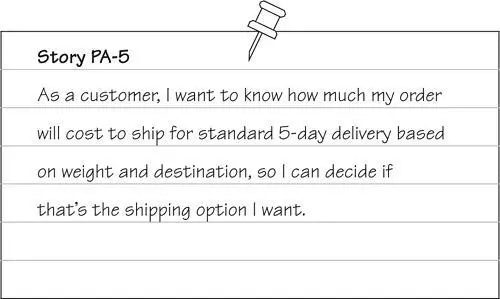Crispin, Lisa - Agile Testing - A Practical Guide for Testers and Agile Teams
Здесь есть возможность читать онлайн «Crispin, Lisa - Agile Testing - A Practical Guide for Testers and Agile Teams» весь текст электронной книги совершенно бесплатно (целиком полную версию без сокращений). В некоторых случаях можно слушать аудио, скачать через торрент в формате fb2 и присутствует краткое содержание. Год выпуска: 2008, Издательство: Addison-Wesley Professional, Жанр: Старинная литература, на английском языке. Описание произведения, (предисловие) а так же отзывы посетителей доступны на портале библиотеки ЛибКат.
- Название:Agile Testing: A Practical Guide for Testers and Agile Teams
- Автор:
- Издательство:Addison-Wesley Professional
- Жанр:
- Год:2008
- ISBN:нет данных
- Рейтинг книги:4 / 5. Голосов: 1
-
Избранное:Добавить в избранное
- Отзывы:
-
Ваша оценка:
- 80
- 1
- 2
- 3
- 4
- 5
Agile Testing: A Practical Guide for Testers and Agile Teams: краткое содержание, описание и аннотация
Предлагаем к чтению аннотацию, описание, краткое содержание или предисловие (зависит от того, что написал сам автор книги «Agile Testing: A Practical Guide for Testers and Agile Teams»). Если вы не нашли необходимую информацию о книге — напишите в комментариях, мы постараемся отыскать её.
Agile Testing: A Practical Guide for Testers and Agile Teams — читать онлайн бесплатно полную книгу (весь текст) целиком
Ниже представлен текст книги, разбитый по страницам. Система сохранения места последней прочитанной страницы, позволяет с удобством читать онлайн бесплатно книгу «Agile Testing: A Practical Guide for Testers and Agile Teams», без необходимости каждый раз заново искать на чём Вы остановились. Поставьте закладку, и сможете в любой момент перейти на страницу, на которой закончили чтение.
Интервал:
Закладка:
Figure 17-1 Iteration planning meeting. Used with permission of Mike Thomas. Copyright 2008.

Learning the Details
Ideally, the product owner and/or other customer team members participate in the iteration planning, answering questions and providing examples describing requirements of each story. If nobody from the business side can attend, team members who work closely with the customers, such as analysts and testers, can serve as proxies. They explain details and make decisions on behalf of the customers, or take note of questions to get answered quickly. If your team went over stories with the customers in advance of the iteration, you may think you don’t need them on hand during the iteration planning session. However, we suggest that they be available just in case you do have extra questions.
As we’ve emphasized throughout the book, use examples to help the team understand each story, and turn these examples into tests that drive coding. Address stories in priority order. If you haven’t previously gone over stories with the customers, the product owner or other person representing the customer team first reads each story to be planned. They explain the purpose of the story, the value it will deliver, and give examples of how it will be used. This might involve passing around examples or writing on a whiteboard. UI and report stories may already have wire frames or mock-ups that the team can study.
A practice that helps some teams is to write user acceptance tests for each story together, during the iteration planning. Along with the product owner and possibly other stakeholders, they write high-level tests that, when passing, will show that the story is done. This could also be done shortly in advance of iteration planning as part of the iteration “prep work.”
Stories should be sized so they’ll take no more than a few days to complete. When we get small stories to test on a regular basis, we do not have them all finished at once and stacked up at the end of the iteration waiting to be tested. If a story has made it past release planning and pre-iteration discussions and is still too large, this is the final chance to break it up into smaller pieces. Even a small story can be complex. The team may go through an exercise to identify the thin slices or critical path through the functionality. Use examples to guide you, and find the most basic user scenarios.
Agile testers, along with other team members, are alert to “scope creep.” Don’t be afraid to raise a red flag when a story seems to be growing in all directions. Lisa’s team makes a conscious effort to point out “bling,” or “nice to have” components, which aren’t central to the story’s functionality. Those can be put off until last, or postponed, in case the story takes longer than planned to finish.
Considering All Viewpoints
As a tester, you’ll try to put each story into the context of the larger system and assess the potential of unanticipated impacts on other areas. As you did in the release planning meeting, put yourself in the different mind-sets of user, business stakeholder, programmer, technical writer, and everyone involved in creating and using the functionality. Now you’re working at a detailed level.
In the release planning chapter, we used this example story:
As a customer, I want to know how much my order will cost to ship based on the shipping speed I choose, so I can change if I want to.
We decided to take a “thin slice” and change this story to assume there is only one shipping speed. The other shipping speeds will be later stories. For this story, we need to calculate shipping cost based on item weight and destination, and we decided to use BigExpressShipping’s API for the calculation. Our story is now as shown in Figure 17-2.
Figure 17-2 Story shipping speed for 5-day delivery

The team starts discussing the story.
Tester:“Does this story apply for all items available on the site? Are any items too heavy or otherwise disqualified for 5-day delivery?
Product Owner:“5-day ground is available for all our items. It’s the overnight and 2-day that are restricted to less than 25 lbs.”
Tester:“What’s the goal here, from the business perspective? Making it easy to figure the cost to speed up the checkout? Are you hoping to encourage them to check the other shipping methods—are those more profitable?”
Product Owner:“Ease of use is our main goal, we want the checkout process to be quick, and we want the user to easily determine the total cost of the order so they won’t be afraid to complete the purchase.”
Programmer:“We could have the 5-day shipping cost display as a default as soon as the user enters the shipping address. When we do the stories for the other shipping options, we can put buttons to pop up those costs quickly.”
Product Owner:“That’s what we want, get the costs up front. We’re going to market our site as the most customer friendly.”
Tester:“Is there any way the user can screw up? What will they do on this page?”
Product Owner:“When we add the other shipping options, they can opt to change their shipping option. But for now, it’s really straightforward. We already have validation to make sure their postal code matches the city they enter for the shipping address.”
Tester:“What if they realize they messed up their shipping address? Maybe they accidentally gave the billing address. How can they get back to change the shipping address?”
Programmer:“We’ll put buttons to edit billing and shipping addresses, so it will be very easy for the user to correct errors. We’ll show both addresses on this page where the shipping cost displays. We can extend this later when we add the multiple shipping addresses option.”
Tester:“That would make the UI easy to use. I know when I shop online, it bugs me to not be able to see the shipping cost until the order confirmation. If the shipping is ridiculously expensive and I don’t want to continue, I’ve already wasted time. We want to make sure users can’t get stuck in the checkout process, get frustrated, and just give up. So, the next page they’ll see is the order confirmation page. Is there any chance the shipping cost could be different when the user gets to that page?”
Programmer:“No, the API that gives us the estimated cost should always match the actual cost, as long as the same items are still in the shopping cart.”
Product Owner:“If they change quantities or delete any items, we need to make sure the shipping cost is immediately changed to reflect that.”
As you can see by the conversation, a lot of clarification came to light. Everyone on the team now has a common understanding of the story. It’s important to talk about all aspects of the story. Writing user acceptance tests as a group is a good way to make sure the development team understands the customer requirements. Let’s continue monitoring this conversation.
Tester:“Let’s just write up some quick tests to make sure we get it right.”
Customer:“OK, how’s this example?
I can select two items with a 5-day shipping option and see my costs immediately.
Читать дальшеИнтервал:
Закладка:
Похожие книги на «Agile Testing: A Practical Guide for Testers and Agile Teams»
Представляем Вашему вниманию похожие книги на «Agile Testing: A Practical Guide for Testers and Agile Teams» списком для выбора. Мы отобрали схожую по названию и смыслу литературу в надежде предоставить читателям больше вариантов отыскать новые, интересные, ещё непрочитанные произведения.
Обсуждение, отзывы о книге «Agile Testing: A Practical Guide for Testers and Agile Teams» и просто собственные мнения читателей. Оставьте ваши комментарии, напишите, что Вы думаете о произведении, его смысле или главных героях. Укажите что конкретно понравилось, а что нет, и почему Вы так считаете.












